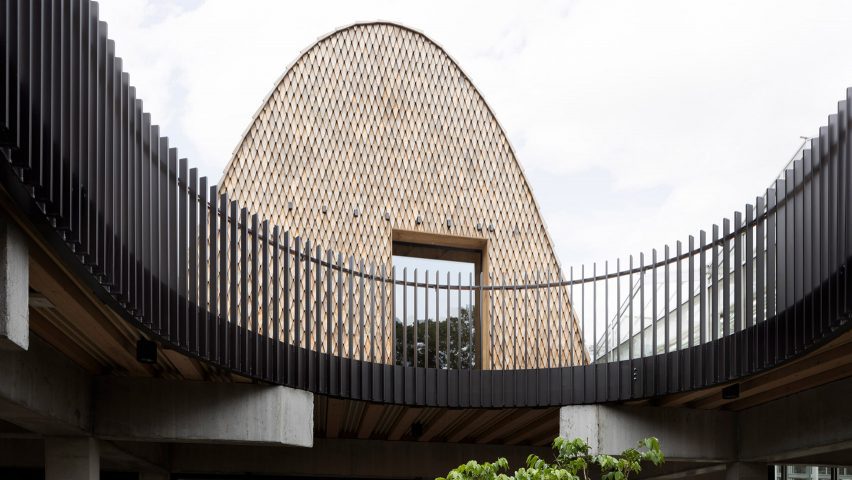Belgian studios NU Architectuuratelier and Archipelago have created a visitor centre for the Meise Botanic Garden near Brussels that is topped by a shingle-clad vaulted roof.
The Green Ark pavilion, which contains educational spaces and a seed bank, was completed as part of the wider renovation of the botanic garden at Bouchout Castle, which contains one of the world's largest collections of endangered plant species.
It sits at the heart of the garden's 7,600-square-metre conservatory complex and was designed by Nu Architectuuratelier and Archipelago to offer a "vantage point" from which to look into these glasshouses.
"The pavilion is nestled in a sea of glasshouses with climate zones from around the world," Nu Architectuuratelier told Dezeen.
"It is the treasury of living plants and seeds that the pavilion unlocks visually for the public," the studio continued.
"This is an impressive multipurpose visitor pavilion that floats, as if inhabited, between the glass walls of the conservatory, designed as an elevated vantage point over the greenhouses around it."
On the ground floor of Green Ark, the fully-glazed interior of the pavilion provides a space for exhibitions, workshops and receptions with views through into the conservatories.
In the centre is a double-height area created beneath the pavilion's distinctive arched roof – a hyperbolic paraboloid formed from an exposed timber grid-shell structure.
"The dome's expressive volume gives form and identity to the invaluable natural value contained in the extensive collection cabinet and seed room," said Nu Architectuuratelier.
"The hyperbole makes a visit to the Botanic Garden memorable. Not through decorative excess, but through sober yet impressive design and an authentic spatial experience," it added.
Sheltering the remainder of Green Ark is a concrete roof that doubles as a terrace. This provides visitors with views across the upper levels of the conservatories and the trees beyond.
From the centre of this concrete terrace emerges the arched roof, which is clad externally in shingles of Kebony wood that were created using leftover timber from the studio's other projects.
"The starting point was to choose a natural material that is timeless and durable," Nu Architectuuratelier told Dezeen. "The shingles allow a three-dimensional surface to be clad without losing strength."
Previous projects by NU Architectuuratelier include a home renovation in Leuven finished with diagonal planks of black-painted timber and a home near Brussels clad entirely in tiles of fibre-cement.
The photography is courtesy of NU Architectuuratelier and Archipelago.

